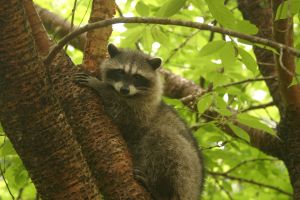Our Non-Human NeighborsKara Tebeau
This summer, I was surprised to see a sign reading "Cougar Sighted in Neighborhood" Encounters with wild animals that are considered dangerous have been on the rise. In fact, complaints about cougars and bears have risen 31 percent in our state since 2003, according to the Washington Department of Fish and Wildlife website. WDFW cites human growth and development in the habitats of these animals as a leading cause of the increase in incidents. More than 35,000 acres of wildlife habitat are developed each year in Washington. Given this figure, we should not be surprised to encounter the odd carnivore, searching for some territory. Though the average homeowner may not be able to do much to mitigate the loss of cougar and bear habitat, there are plenty of things that can be done to make back yards into sanctuaries for other displaced creatures. In the average neighborhood in our state, one can find about 25 different species of birds and mammals. There are ways to landscape our yards to make havens for these creatures. The basics include providing shelter, food (via plants), water, and space. When landscaping and choosing plants, the WDFW website reminds us to think of using diverse native plants, leaving variety in the heights of plants, avoiding insecticide use, and including more than one habitat type. Nest boxes can also attract animals to our yards. Providing plants that supply food and habitat allows for wildlife viewing without the side effects. A forest fringe in my front yard naturally supplies plants and shelter that deer enjoy. My family has been very lucky this year; a mother doe has chosen our yard as one of her favorite hideouts for her fawns. Near our home, we are also fortunate to have heron habitat. It is always a joy to view wildlife from my bedroom window. Some animal magnets, however, can cause problems. Feeding wildlife directly or leaving out garbage and pet food may cause animals to become dependent and bold. In this way, people have come to think of some species as nuisances. Raccoons were often identified as animals of concern by people I interviewed, and I have personally been accosted by rogue hungry gray squirrels. There are plenty of resources available to help people create backyard sanctuaries. The Department of Fish and Wildlife website includes ideas for landscaping and other projects, information on how to attract specific species, and instructions for ordering the Backyard Wildlife Sanctuary Packet. Visit: http://wdfw.wa.gov/wlm/backyard/index.htm Kara Tebeau is a Green Pages board member.
Back to Home page. |

 posted on the reader-board by my home near Lacey. Recent cougar sightings in Thurston County have brought the issue of suburban human-animal interaction into the limelight.
posted on the reader-board by my home near Lacey. Recent cougar sightings in Thurston County have brought the issue of suburban human-animal interaction into the limelight.